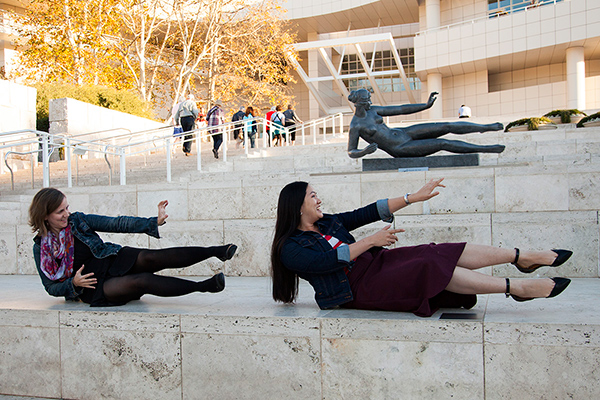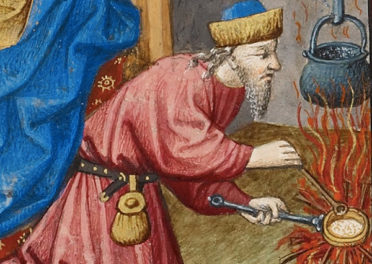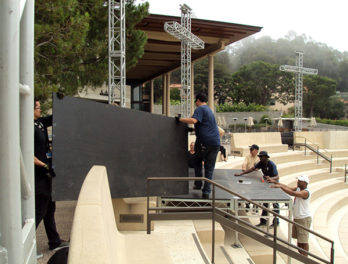Starting today we’re challenging you to closely observe and imitate some of the biggest posers at Getty—posers in art, that is. Snap a photo of you imitating art and show your stuff on Instagram with the hashtag #MusePose. We’ll be featuring a new object each month at the Getty Center and the Getty Villa and regramming some of our faves (after asking permission).
Do an Elegant Leg Lift at the Getty Center

Audrey Chan and Kelly Williams strike a #MusePose duet! Sculpture: Air, designed 1938, cast 1962, Aristide Maillol. Lead, 94 in. long. The J. Paul Getty Museum, 2005.113.1
At the Getty Center (Instagram: @GettyMuseum), our first #MusePose pick is Aristide Maillol’s Air, located on the steps leading up to the Museum. Massive yet seemingly weightless, this female figure seems caught in flight even though she is made from lead, one of the densest materials on earth. In fact, Air weighs over 1,500 pounds! The grayish-blue surface of the metal gives the figure an airiness that belies her bulk.
#MusePose Tip: If you look closely at Air, you’ll see that the entire figure rests on her right hip, as if she is alighting gently on her leaden plinth. This makes posing like the woman especially challenging. We struck her pose on the bottom step of the museum last week, and it took a few tries to raise our legs parallel to the ground, position our hands just so and replicate her gaze over her fingertips. We’re excited to see you strike a similar pose this month.
Unleash Your Inner Beast at the Getty Villa

Anna Woo unleashes her inner ursus. Sculpture: Bear, A.D. 100–125, Roman. Marble, 67 3/8 in. long. The J. Paul Getty Museum, 72.AA.125
Posing isn’t just for the two-legged! Our first #MusePose at the Getty Villa (Instagram: @GettyVilla) is Bear, who stalks the second-floor corridor gallery alongside other animals from antiquity. It is depicted mid-stride, climbing a rocky landscape in the wilds of the Roman Empire.
What could be provoking Bear’s head-turning gaze? During the 100s A.D. when this sculpture was made, Roman emperor Hadrian popularized the sport of hunting among Roman nobility. The act of slaying such a fierce and noble beast was a symbol of human strength and bravery. Bear may have once been part of a large-scale sculptural grouping depicting a hunt in carved and painted marble.
#MusePose Tip: When trying out the pose, channel your inner ursus (Latin for “bear”). In the photo above, our colleague Anna is doing a great job hunching her back and assuming the bear’s striding pose. Note the bear’s elegantly extended back leg and the slight twist of his body as he climbs uphill. Though the details on his face have worn away, we can see he once had a ferocious expression.
Next Up in #MusePose
The idea for #MusePose was born from a simple observation: it’s great fun to imitate works of art. It’s also a real looking challenge, to get the pose just so.
In future months, we’ll pick impersonate a king and contort seductively with a goddess. And we hope you’ll take the game further, posing at home and at other museums too! No matter the location, we invite you to share your #MusePose photos with us on Instagram.




Maravilloso!!